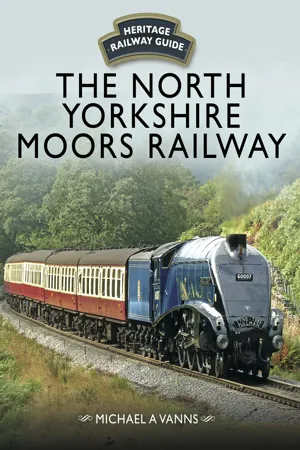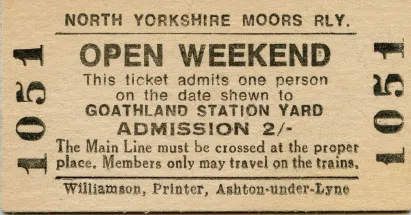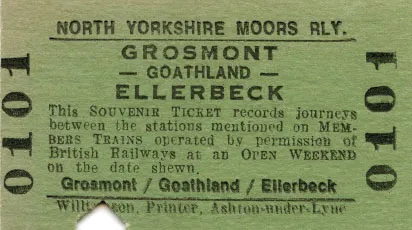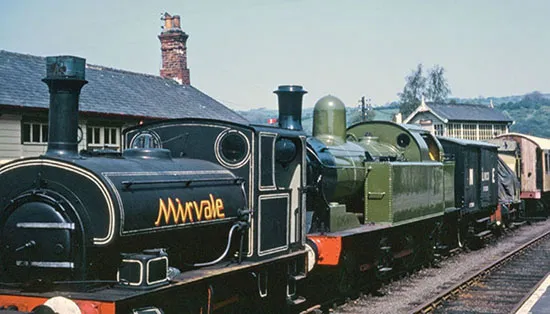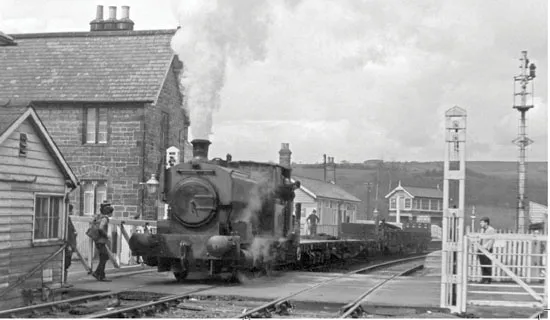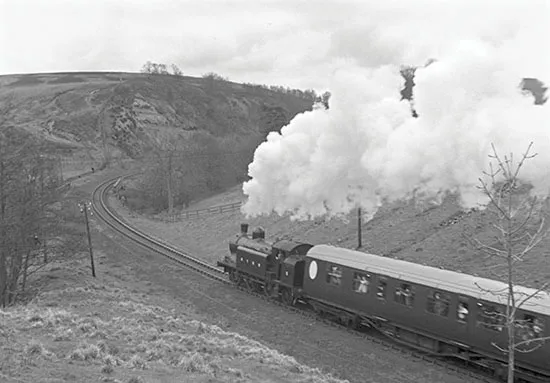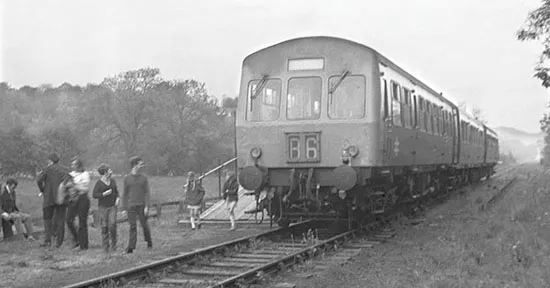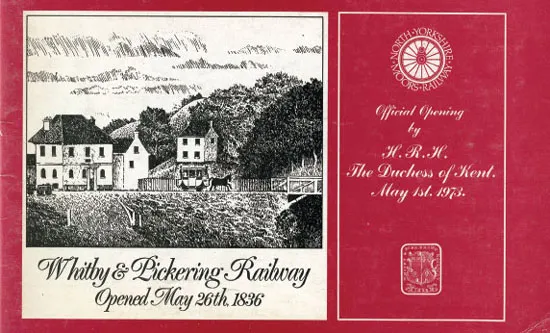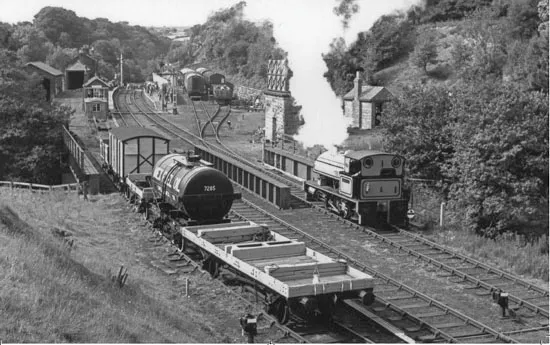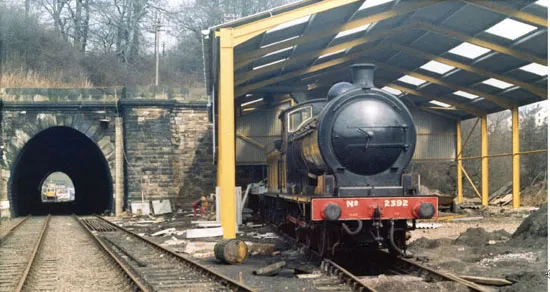![]()
Revival
When the closure plans were announced, there were three good reasons put forward for retaining the line between Grosmont and Pickering. The first was to maintain a public service. The second was as a tourist attraction, a place where you could travel on a steam train. The third was as a way of controlling access to the North York Moors National Park (designated as such in 1952) by persuading visitors out of their cars and into trains. All three arguments were put forward immediately before and then after closure, but it was the second reason that initially triumphed over the others.
Two powerful drivers ensured the North Yorkshire Moors Railway (NYMR) emerged as a tourist attraction. The first was the timing of the closure. There had been widespread dismay at what the Beeching Plan of 1963 had wrought on the national rail network. In very few places had the case for closure of a line or station been successfully challenged. This impotency in the face of officialdom had inspired many to seek to run their own lines, spurred on by the achievement of the Bluebell Railway Preservation Society in 1960, and by the fighting spirit shown by other groups such as the one trying to reopen the Keighley & Worth Valley Railway.
These groups, and others that were emerging, were also symptoms of a wider reaction to the 1960s remodelling of the country’s towns and cities and the replacement of Georgian and Victorian architecture with concrete tower blocks, shopping precincts and octopus-like road schemes. For a new generation, post-war modernisation had become tarnished. As the planners continued to pursue the demolish–rebuild happiness dream, there was an increasing number of ordinary people who were prepared to turn up at weekends and get their hands dirty digging out overgrown canals and rescuing all kinds of ordinary, ‘working class’ things that had been rapidly disappearing over the previous decade. These people were unpaid, it was not their job, they were not museum curators, but they wanted to preserve mills, mangles and milling machines, and perhaps the most emotive of all Victorian engineering achievements that were going to the scrap yards – steam locomotives.
The elimination of steam engines from British Railways in 1968 and the subsequent ban of running any but the Flying Scotsman on the national network after that date further encouraged the preservationists. If steam engines were to be seen, heard and smelt, then it had to be on private lines run by volunteers. All this desire to preserve, however, would have borne different fruit if the NYMR had not passed through such inspiring scenery, and this was undoubtedly the second most important reason for the success of this railway as a tourist attraction. It is one of those ironies not always voiced, that although steam locomotives were products of an industrialised nation, in which the majority of the population lived and worked in towns and cities, most people go to visit them and travel behind them because they run in the countryside.
Built in 1955, saddle tank 0-4-0 Mirvale was the first steam locomotive to be operated on the North Yorkshire Moors Railway (NYMR) by the new preservation society, at the beginning of 1969. The engine was named after the firm it originally worked for – Mirvale Chemicals in Mirfield. It is seen here at Goathland station on Easter Monday, 12 April 1971, only sixteen days after the North Yorkshire Moors Historical Railway Trust had been created. (Tony Wickens/Online Transport Archive/2604)
The First 25 Years (1967–1993)
British Railways had been obliged to leave the track in situ between Grosmont and Rillington Junction for two years after closure. As the expiry of this embargo approached, efforts to acquire the section of line between Grosmont and Pickering rested with the North Yorkshire Moors Railway Preservation Society (NYMRPS), formed in November 1967. With a price tag of £120,000 beyond the reach of the new group, the more realistic target became the purchase of all the trackbed, but only a single line of rails for 5.5 miles (8.85km) from Grosmont southwards through Goathland to the summit of the line near Ellerbeck (where the line came closest to the A169). The hope was to extend as future fundraising allowed. Membership of the society increased steadily, and by May 1969 it was able to pay British Railways a 10% deposit on the £42,500 asking price. If they had been unsure of the success of the society before, this event demonstrated to the North York Moors National Parks management that trains would soon be running into the heart of the Park and, rather than reduce the number of cars on local roads, it had the potential to encourage more.
Ticket No. 1051 issued by the NYMR at Goathland station on 27 June 1970 for two shillings (10p). (Author’s collection)
Ticket No. 101, one of those issued on 27 June 1970 to members of the NYMR for travel between Grosmont and Ellerbeck, three years before the line was reopened through to Pickering. (Author’s collection)
Ellerbeck was remote enough, and the disruption caused by creating and then operating a new terminus for the railway there encouraged the Parks Committee and North Riding Council to offer to purchase for the NYMRPC a single track southwards from there to Pickering, thus creating an eighteen mile long preserved railway. In 1969, no preservation society anywhere in the country was operating more than a few miles of single track, but the society was prepared to rise to the challenge.
Grosmont became the centre of activities, with volunteers operating small tank steam locomotives at weekends and Bank Holidays to raise much needed funds. In June 1970 the North Eastern Locomotive Preservation Group’s (NELPG) 1918-built NER Class T2 0-8-0, along with Lambton Tank 0-6-2T No. 29 built in 1904, were delivered to the railway. Two months later the latter’s sister No. 5 arrived, to be joined in October the following year by the NELPG’s 1923-built NER P3 Class 0-6-0. At the very end of that year, the North York Moors Historical Railway Trust (NYMHRT) was created to succeed the NYMRPS, becoming the first registered charity to operate a preserved railway. Paid staff were recruited to join the volunteers, the Light Railway Order for operating trains on the line was transferred from British Rail to the preservationists, and on 1 May 1973, the Duchess of Kent officially opened the North Yorkshire Moors Railway (NYMR). Steam trains for the paying public were then run between Grosmont and Goathland, with a diesel multiple unit (DMU) service to and from Levisham and the outskirts of Pickering.
The fact that trains were not able to use Pickering station at the time indicates that in the late 1960s and early 1970s not everyone was supportive of enthusiastic amateurs running railways. With the line through the town closed, Pickering Urban District Council had plans to modify the town’s road layout by eliminating the level crossings on Bridge Street and Hungate and demolishing the station so that the site could be used for a supermarket and car park. The Council’s application to compulsorily purchase the station site provoked a public enquiry at which Council representatives did not help their cause by describing the NYMR as ‘… a plaything for the affluent society.’ A petition in favour of retaining the station was signed by 1,400 local residents with only 33 in opposition, and with over 75,000 tickets sold since passenger services restarted, the sensible outcome was that Pickering station should remain for the use of NYMR’s trains.
Lined up in the down Platform 2 at Grosmont station on 20 May 1972 are Mirvale and Lambton Tank 0-6-2T, No. 29, the latter having been bought by NYMR and North Eastern Locomotive Preservation Group (NELPG) members in 1970. This engine was built in 1904 by Kitson & Co. of Leeds for working on the Lambton Colliery railway system. (Author’s collection)
Brought to the NYMR in 1969, 0-6-0ST Salmon was built by Andrew Barclay & Sons of Kilmarnock in 1942 to work at Stewarts & Lloyds ironstone quarries in Lincolnshire. It was named after HMS Salmon, a British submarine sunk in 1940. Mirvale and Salmon were in steam at most open days, keeping the public interested and involved until a full passenger service could be operated. In this undated photograph, Salmon pulls an engineering train over the level crossing at Grosmont sometime between 1969 and 1971. (Author’s collection)
In this photograph taken at Darnholm on 12 April 1971, Lambton Tank No. 5 is seen climbing the 1 in 49 towards Goathland only eight months after it had arrived on the NYMR. It was constructed by Robert Stephenson & Co. at Darlington in 1909 for use at Lambton Colliery, County Durham. Following a number of mergers with other collieries, by 1924 the Lambton Colliery had expanded its name to Lambton, Hetton & Joicey Collieries, explaining why 0-6-2T No. 5 and 0-6-2T No. 29 have been outshopped at various times in a livery with the initials of this post-1924 company. (Tony Wickens/Online Transport Archive /2609)
Only a month after the NYMR’s service south of Goathland had begun, the diesel multiple unit (DMU) hired from British Rail stands at the temporary platform just north of Pickering on 28 May 1973. (Tony Wickens/Online Transport Archive /2604)
Front cover of the booklet issued to commemorate the opening of the NYMR by HRH The Duchess of Kent on 1 May 1973. (Author’s collection)
Pottering about at Goathland in either the summer of 1972 or 1973, is 0-4-0ST No. 15 Eustace Forth, which had arrived on the railway in June 1972 and stayed until January 1978. It had been built in 1942 by Robert Stephenson and Hawthorns (a 1937 amalgamation of Robert Stephenson & Co. of Darlington and Hawthorn Leslie & Co. of Newcastle-upon-Tyne), and had been working before preservation at Dunston Power Station. (Stephenson Locomotive Society)
Pickering station in its final British Railway condition which, apart from the inevitable later growth of weeds, was largely the condition it was in when taken over by the NYMR in 1975. (Lens of Sutton Association/36431)
Another Light Railway Order was granted and the station came back into use on 24 May 1975. With the public enquiry out of the way, Pickering Urban District Council wasted no time in demolishing the goods shed and coal drops between Bridge Street and Hungate, driving through a new road on the former track bed and laying out a public car park between those two roads.
For the new NYMR, the reverberations of the decision to operate the longest preserved railway in the country continued throughout that decade. The first chairman of the Trust, Richard Rowntree, expressed misgivings about the move away from a ‘little’ line that he believed could be run with volunteers, to one that might be considered as part of a strategy by others to keep road traffic out of a national park and would need far more resourcing than volunteers could muster. His opinion was supported, when in 1974 it was revealed that because British Rail were not able to provide second-hand track to repair and renew the line between Ellerbeck and Pickering at the £6,000 it had quoted, the NYMR had been obliged to spend in excess of £21,000 on renewals. The North York Moors National Park Committee was quickly made aware of this and agreed to inject £20,000 into track upgrading. In April 1981, when the single platform Newton Dale Halt was opened between Levisham and Goathland, it was primarily of benefit to those using the National Park rather than meeting any needs the NYMR might have had in that remote spot.
Former NER Class P3 0-6-0 No. 2392 inside the partly completed new locomotive shed south of Grosmont Tunnel in March 1973. After heading the NYMR re-opening train from Whitby on 1 May that year it went on to share the burden of hauling passenger serv...
